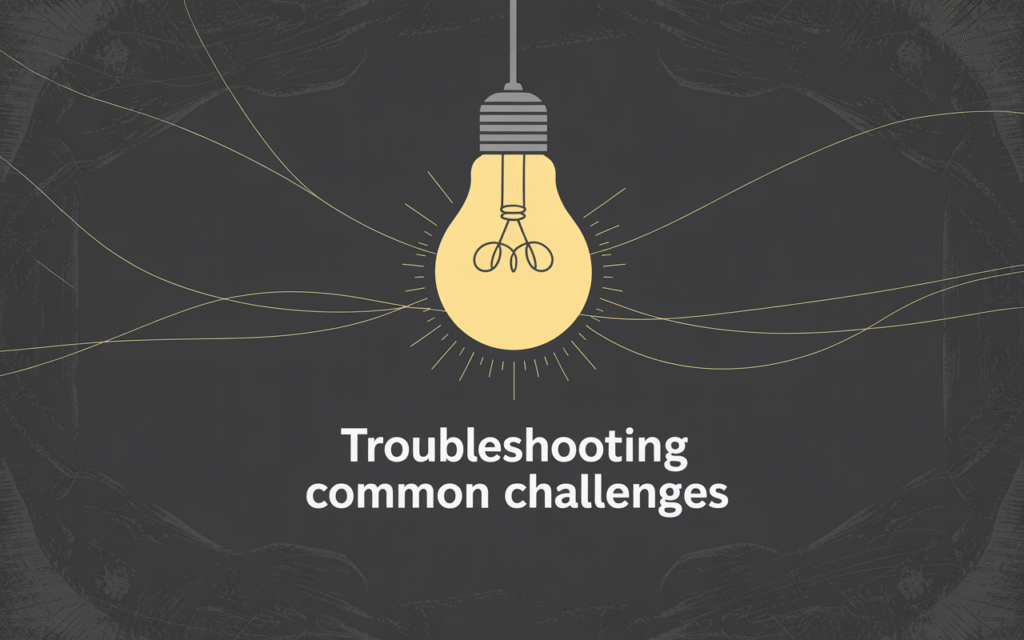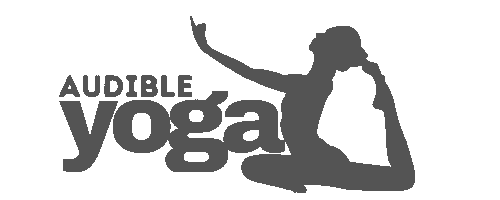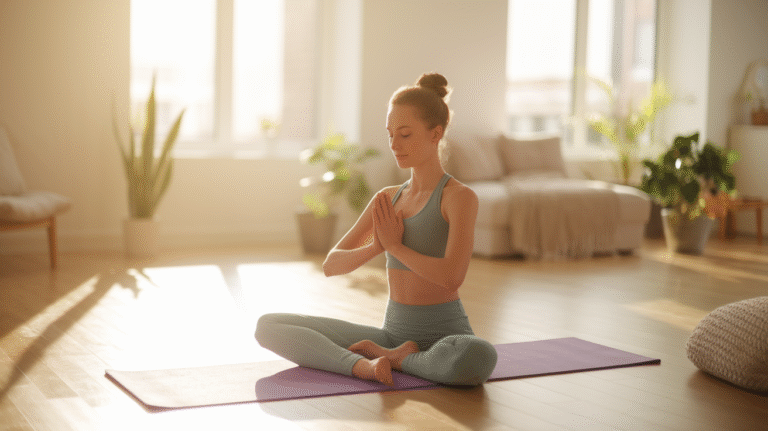Yoga for Digital Detox: Best for Screen-Tired Bodies

Here’s a wild stat that might make you uncomfortable: the average person checks their phone 96 times a day and spends over 7 hours staring at screens.
That’s nearly half your waking hours! Think about your typical day – you probably wake up and immediately reach for your phone, spend 8+ hours at a computer, scroll through social media during lunch, and wind down with Netflix. Sound about right?
Here’s what’s fascinating (and maybe a little ironic): we’re about to use 5,000-year-old practices to solve our most modern problem.
These ancient yoga techniques can literally reverse the physical and mental damage of our digital age – and honestly, they might be the sanity-saving solution you didn’t know you needed.
The Hidden Cost of Our Screen-Obsessed Lives

Let’s talk about what all this screen time is actually doing to us, because it’s way more than just tired eyes.
Physically, we’re a mess. Tech neck is now so common that chiropractors are calling it an epidemic. That forward head posture from constantly looking down at devices? It’s adding up to 60 pounds of extra pressure on your spine. No wonder your shoulders are permanently hunched up around your ears!
Then there’s digital eye strain – you know, that gritty, tired feeling in your eyes after a long day of screens, the headaches, the blurred vision.
Your eyes aren’t designed to focus on something 18-24 inches away for hours on end. And don’t even get me started on what we’ve done to our poor wrists and thumbs with all that typing and swiping.
But here’s something you might not have noticed: screen time is literally changing how you breathe. It’s called “email apnea” – we actually hold our breath or breathe super shallowly when we’re focused on screens. Try paying attention to your breathing next time you’re deep in your inbox. Crazy, right?
Mentally and emotionally, the damage runs even deeper. Our attention spans are getting shorter (thanks, TikTok), we’re addicted to the dopamine hits from notifications, and we’re living in a constant state of low-level anxiety about missing something important online. FOMO isn’t just a cute acronym – it’s rewiring our brains to be constantly restless and never fully present.
The worst part? All this digital stimulation is keeping our nervous systems stuck in fight-or-flight mode. We’re treating Instagram notifications like saber-toothed tigers, and our poor adrenal glands are exhausted from the constant false alarms.
Why Yoga is the Perfect Antidote to Digital Overwhelm

This is where yoga becomes absolutely brilliant. Think about it – everything that screens do to us, yoga undoes.
Screens pull our attention outward and fragment it into a million pieces. Yoga brings our attention inward and teaches us to focus on one thing at a time.
Screens keep us stuck in our heads, disconnected from our bodies. Yoga reconnects us to physical sensations and embodied awareness.
Screens trigger our sympathetic nervous system (fight-or-flight). Yoga activates our parasympathetic nervous system (rest-and-digest). It’s literally the perfect opposite medicine for our digital overwhelm.
The ancient yogis were basically attention-training experts, and we desperately need their wisdom in our age of infinite distractions. They developed practices specifically designed to cultivate sustained focus, inner calm, and present-moment awareness – exactly what we’re losing to our devices.
Your Complete Digital Detox Yoga Toolkit

Ready to fight back against screen fatigue? Here’s your arsenal of ancient practices for modern problems.
Phase 1: Physical Recovery Sequences
Tech Neck Relief Flow (15 minutes)
Let’s start by undoing the damage to your poor neck and shoulders. This sequence is like a massage therapist and physical therapist rolled into one.
Begin with gentle neck movements – slowly turn your head right, then left, like you’re saying “no” to more screen time (how appropriate!).
Then nod your head up and down like you’re saying “yes” to taking better care of yourself. Do this for about a minute, moving slowly and mindfully.
Next, we’re going to work on those tight shoulders. Roll them up, back, and down in big circles, then reverse the direction. Feel all that tension from hunching over your laptop start to release.
Now for the good stuff – chest opening. Stand in a doorway with your arms in a goal-post position against the door frame.
Step one foot forward and lean gently forward to stretch your chest and front shoulders. Hold for 30 seconds and feel your heart space literally opening up after being collapsed forward all day.
Finish with some cat-cow movements, but focus on the upper spine. Get on your hands and knees, and as you arch your back (cow), really lift your chest and look up.
As you round your spine (cat), focus on creating space between your shoulder blades. This is like wringing out a sponge – you’re literally squeezing out the tension and bringing in fresh circulation.
Eye Relief and Vision Restoration (10 minutes)
Your eyes are probably screaming for help, so let’s give them some love. Start by rubbing your palms together vigorously until they’re warm, then cup them over your closed eyes.
This is called palming, and it’s like a mini spa treatment for your eyeballs. Just rest here for a minute and let your eyes drink in the darkness.
Next, we’re going to do some yogic eye exercises. Keep your head still and trace a figure-8 with your eyes, going slowly and smoothly.
Then shift your focus from something close (like your finger held 6 inches from your face) to something far away (across the room or out a window).
This helps retrain your eyes to focus at different distances instead of being stuck in that 18-24 inch computer screen zone.
Try some balancing poses too – tree pose or warrior III. Balance challenges your visual system in a really healthy way and helps counteract the static visual input of screens.
Wrist and Hand Recovery (8 minutes)
Time to show some love to those overworked hands and wrists. Start in prayer position at your heart, then slowly lower your hands while keeping your palms together. You’ll feel a nice stretch through your wrists and forearms.
Do some wrist circles – both directions – and gently flex and extend your wrists. Make fists and then spread your fingers wide. It sounds simple, but you’re literally undoing hours of repetitive strain.
Here’s a fun one: try some hand mudras (symbolic hand positions). My favorite for digital detox is placing your thumb and index finger together while extending the other three fingers.
This is called Gyan mudra, and it’s said to enhance concentration and calm the mind – perfect for breaking the digital distraction habit.
Phase 2: Breathing Practices for Digital Reset
Remember that “email apnea” I mentioned? Let’s fix that right now.
Three-Part Yogic Breathing
This is your antidote to shallow, stressed-out screen breathing. Lie down or sit comfortably and place one hand on your chest, one on your belly.
Breathe into your belly first (bottom hand rises), then your ribcage (sides expand), then your upper chest (top hand rises slightly). Exhale in reverse – chest, ribs, belly. Do this for 5-10 breaths and feel your nervous system start to shift out of stress mode.
4-7-8 Breathing for Instant Reset
This one’s like a reset button for your nervous system. Inhale for 4 counts, hold for 7 counts, exhale for 8 counts. Repeat 4 times. It’s amazing for those moments when you’ve been doom-scrolling and suddenly realize you’re totally wired and anxious.
Box Breathing for Sustained Focus
Perfect for when you need to concentrate after your attention has been scattered by notifications. Inhale for 4, hold for 4, exhale for 4, hold for 4. Repeat for 5-10 rounds. This creates the kind of calm, focused state that makes you way more productive than any amount of caffeine.
Phase 3: Mindfulness and Mental Detox Practices
Attention Training Meditation
This is where we directly counteract the attention-fragmenting effects of digital overwhelm. Start with just 5 minutes of focusing on one thing – your breath, a candle flame, or even a sound like a singing bowl.
When your mind wanders (and it will, because it’s been trained by technology to jump around constantly), gently bring it back to your focus point. You’re literally retraining your brain to sustain attention on one thing instead of jumping between notifications.
Digital Mindfulness Practices
Here’s where it gets really practical. Start setting intentions before you pick up your phone. Ask yourself: “What am I looking for right now?” This simple question can break the unconscious phone-grabbing habit.
Try using notifications as mindfulness bells. Instead of immediately reacting when your phone buzzes, take one conscious breath first. This creates a pause between stimulus and response – exactly what mindfulness is all about.
Create transition rituals between screen activities. Do three neck rolls before checking email. Take five deep breaths before starting work on your computer. Stand up and stretch before picking up your phone. These mini-practices help you stay present instead of moving unconsciously from screen to screen.
Creating Your Personal Digital Detox Yoga Routine

The 5-Minute Screen Break (Every 30 Minutes)
Set a timer and every half hour, do this quick sequence:
- 10 neck rolls (slow and mindful)
- 10 shoulder shrugs
- 1 minute of eye palming
- 20 deep breaths
It sounds almost too simple, but this alone will transform how you feel at the end of a screen-heavy day.
The 20-Minute Lunch Hour Reset
When you’re halfway through your workday and your brain feels fried:
- 5 minutes of the tech neck flow
- 8 minutes of heart-opening poses (camel, fish, or simple backbends)
- 5 minutes of breathing practice
- 2 minutes of quiet meditation
This is like hitting the reset button on your entire day. You’ll come back to work feeling like a different person.
The 45-Minute Evening Digital Detox Flow
This is your transition ritual from screen mode to human mode:
- 15 minutes of flowing movement to literally shake off the day
- 10 minutes of restorative poses (legs up the wall is perfect)
- 10 minutes of breathing practice
- 10 minutes of meditation or quiet reflection
Make this your daily practice, and watch how much better you sleep and how much more present you become with your family.
Lifestyle Integration: Beyond the Mat

Creating Sacred Tech Boundaries
Here’s where yoga philosophy meets modern life. Designate phone-free zones – your bedroom, the dinner table, the first hour of your morning. These become sacred spaces where you practice being fully present.
Before you check any device, take three conscious breaths. This tiny ritual creates space between you and the digital pull, helping you approach technology with intention instead of compulsion.
Environmental Design for Digital Wellness
Create a dedicated yoga space in your home that’s completely tech-free. Even if it’s just a corner with a yoga mat and a candle, having this sanctuary reminds you that there’s life beyond screens.
Pay attention to lighting too. Get outside for natural light during the day, and consider blue light blocking glasses for evening screen use. Your circadian rhythms will thank you.
Measuring Your Digital Detox Success

You’ll know this is working when:
Physically: Your neck and shoulders feel looser, your posture naturally improves, you sleep better, and your eyes feel less strained.
Mentally: Your attention span increases, you feel less anxious when separated from your phone, and you’re more emotionally balanced throughout the day.
Behaviorally: You stop compulsively reaching for your phone, you’re more present in conversations, and you actually enjoy activities without documenting them on social media.
Your 30-Day Digital Detox Yoga Challenge

| Week | Daily Practice | Focus | Duration |
|---|---|---|---|
| Week 1 | 5-minute screen breaks every few hours + 10-minute evening routine | Notice how screens affect your body and breath | 25-30 minutes total |
| Week 2 | Add 20-minute midday reset + extend evening practice to 20 minutes | Start experimenting with phone-free zones | 45-50 minutes total |
| Week 3 | Try full 45-minute evening flow + weekend longer practices | Customize what works for your schedule | 60-90 minutes total |
| Week 4 | Focus on creating lasting habits and boundaries | Make healthy practices as automatic as reaching for your phone | Personalized routine |
Troubleshooting Common Challenges

“I don’t have time for yoga breaks!” Start with literally 30 seconds. Three deep breaths between emails. A quick neck stretch during conference calls. The time investment is tiny, but the returns are massive.
“I can’t focus without checking my phone!” This is withdrawal, and it’s totally normal. Start with super short practices and gradually build up. Your attention span is like a muscle that’s been weakened – it takes time to strengthen it again.
“My work requires constant screen time.” I get it. Focus on the practices you can do while still working – breathing techniques, posture awareness, micro-movements. Even small changes add up to big benefits.
Reclaiming Your Life from the Screen

Here’s what I love about using yoga for digital detox: you’re not just managing screen fatigue – you’re actually building a different relationship with technology entirely.
Instead of being pulled around by every notification and update, you become the conscious director of your attention and energy.
This isn’t about becoming a digital hermit or throwing your phone in a drawer forever. It’s about using ancient wisdom to help you engage with modern technology in a way that serves your wellbeing instead of depleting it.
The practices I’ve shared with you have helped thousands of people reclaim their attention, reduce their stress, and remember what it feels like to be fully present in their own lives. The best part? You can start right now, wherever you are.
So here’s your challenge: close your laptop after reading this, put your phone in another room, and spend just 5 minutes doing some neck rolls and deep breathing. Notice how different you feel when you give your nervous system a chance to reset.
Your body remembers what it feels like to be calm and focused – sometimes it just needs a gentle reminder. That reminder is yoga, and it’s been waiting 5,000 years to help you find your way back home to yourself.
Ready to log off and tune in? Your most present, peaceful self is just one breath away.






